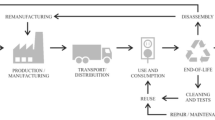Abstract
Sustainable product life cycle management aims at minimizing the negative impacts on the environment, society, and economy by managing different stages of a product’s existence. Proper management of the product life cycle thus leads to a reduction in several types of waste such as materials, energy, and time. While there is significant progress on the key enabling technologies and resources for sustainability within the last decade, the traditional models used for product life cycle sustainability are outdated thus hindering a successful shift toward a circular economy and hence these outdated models should be updated properly to cover the needs of the modern manufacturing landscape. In this paper, we challenge the traditional way of managing a product’s life cycle and propose a new sustainable product life cycle approach with the emphasis on multiple life cycles of products as well as their components and materials through iterative repurposing and reuse, and by integrating the disposal concept from the early phases of conception and design for achieving global sustainability. We highlight that by adopting the proposed approach, it is possible to achieve a longer period of actual use of products and save a significant amount of resources.
Access this chapter
Tax calculation will be finalised at checkout
Purchases are for personal use only
Similar content being viewed by others
References
Kos, K.: Modularity: A Key Concept in Product Life-cycle Engineering. Handbook of Life-cycle Engineering (1998). pp. 511–530
Klöpffer, W.: Life cycle assessment. Environ. Sci. Pollut. Res. 4, 223–228 (1997). https://doi.org/10.1007/BF02986351
Tipnis, V.A.: Product life cycle economic models — towards a comprehensive framework for evaluation of environmental impact and competitive advantage. CIRP Ann. 40, 463–466 (1991). https://doi.org/10.1016/S0007-8506(07)62030-7
Brundtland, G.H.: Our common future—call for action. Environ. Conserv. 14, 291–294 (1987). https://doi.org/10.1017/S0376892900016805
Curran, M.A.: Life Cycle Assessment Handbook: A Guide for Environmentally Sustainable Products (2012). https://doi.org/10.1002/9781118528372
Heijungs, R., Huppes, G., Guinée, J.B.: Life cycle assessment and sustainability analysis of products, materials and technologies. Toward a scientific framework for sustainability life cycle analysis. Polym. Degrad. Stab. 95(3), 422–428 (2010). https://doi.org/10.1016/j.polymdegradstab.2009.11.010
Niemann, J., Tichkiewitch, S., Westkamper, E., et al.: Design of sustainable product life cycles. Design Sustain. Prod. Life Cycles 1–209 (2009). https://doi.org/10.1007/978-3-540-79083-9
Kiritsis, D.: Closed-loop PLM for intelligent products in the era of the Internet of things. Comput. Aided Des. 43, 479–501 (2011). https://doi.org/10.1016/J.CAD.2010.03.002
Liu, W., Beltagui, A., Ye, S.: Accelerated innovation through repurposing: exaptation of design and manufacturing in response to COVID-19. R&D Manag. 51, 410–426 (2021). https://doi.org/10.1111/RADM.12460
Dušková, M.: Key enabling technologies and measuring of the company performance in relation to sustainable development: evaluation model design. Int. J. Innov. Sustain. Dev. 15, 1–34 (2021)
Geissdoerfer, M., Savaget, P., Bocken, N.M.P., Hultink, E.J.: The circular economy – a new sustainability paradigm? J. Clean. Prod. 143, 757–768 (2017). https://doi.org/10.1016/J.JCLEPRO.2016.12.048
Dean: Pricing policies for new products (HBR Classic). Harv. Bus. Rev. 28, 45–50 (1976)
Levitt, T.: Exploit the product life cycle (1995)
Mercer, D.: A two-decade test of product life cycle theory. Br. J. Manag. 4, 269–274 (1993). https://doi.org/10.1111/J.1467-8551.1993.TB00063.X
Mitchell, S.L., Clark, M.: Reconceptualising product life-cycle theory as stakeholder engagement with non-profit organisations. J. Market. Manag. 35, 13–39 (2019). https://doi.org/10.1080/0267257X.2018.1562487
Law, K.L., Narayan, R.: Reducing environmental plastic pollution by designing polymer materials for managed end-of-life. Nat. Rev. Mater. 7(2), 104–116 (2021). https://doi.org/10.1038/s41578-021-00382-0
Machac, J., Steiner, F., Tupa, J.: Product life cycle risk management. Risk Manag. Treatise Eng. Practit. (2017). https://doi.org/10.5772/INTECHOPEN.68797
Hood, B.: Make recycled goods covetable. Nature 531(7595), 438–440 (2016). https://doi.org/10.1038/531438a
Rosenboom, J.-G., Langer, R., Traverso, G.: Bioplastics for a circular economy. Nat. Rev. Mater. 7(2), 117–137 (2022). https://doi.org/10.1038/s41578-021-00407-8
Kiser, B.: Circular economy: Getting the circulation going. Nature 531(7595), 443–446 (2016). https://doi.org/10.1038/531443a
Cabernard, L., Pfister, S., Oberschelp, C., Hellweg, S.: Growing environmental footprint of plastics driven by coal combustion. Nature Sustain. 2021, 1 (2021). https://doi.org/10.1038/s41893-021-00807-2
Sovacool, B.K., Newell, P., Carley, S., Fanzo, J.: Equity, technological innovation and sustainable behaviour in a low-carbon future. Nat. Hum. Behav. 2022, 1–12 (2022). https://doi.org/10.1038/s41562-021-01257-8
Dong, Y., Zhao, Y., Wang, H., et al.: Integration of life cycle assessment and life cycle costing for the eco-design of rubber products. Sci. Rep. 12, 1–19 (2022). https://doi.org/10.1038/s41598-021-04633-6
Psarommatis, F., May, G., Dreyfus, P.-A., Kiritsis, D.: Zero defect manufacturing: state-of-the-art review, shortcomings and future directions in research. Int. J. Prod. Res. 7543, 1–17 (2020). https://doi.org/10.1080/00207543.2019.1605228
Psarommatis, F., Sousa, J., Mendonça, P., et al.: Zero-defect manufacturing the approach for higher manufacturing sustainability in the era of industry 4.0: a position paper. Int. J. Prod. Res. (2021). https://doi.org/10.1080/00207543.2021.1987551
Psarommatis, F., Bravos, G.: A holistic approach for achieving sustainable manufacturing using zero defect manufacturing: a conceptual framework. Procedia CIRP 107, 107–112 (2022). https://doi.org/10.1016/J.PROCIR.2022.04.018
El Jamal, D., Ananou, B., Graton, G., et al.: Similarity-based brownian motion approach for remaining useful life prediction, pp. 1–7 (2021). https://doi.org/10.1109/ICCAD52417.2021.9638776
Shuaib, M., Seevers, D., Zhang, X., et al.: Product sustainability index (ProdSI). J. Ind. Ecol. 18, 491–507 (2014). https://doi.org/10.1111/JIEC.12179
Acknowledgments
The presented work was partially supported by the projects Eur3ka and QU4LITY, EU H2020 projects under grant agreements No 101016175 and No 825030 accordingly. The paper reflects the authors’ views, and the Commission is not responsible for any use that may be made of the information it contains.
Author information
Authors and Affiliations
Corresponding author
Editor information
Editors and Affiliations
Rights and permissions
Copyright information
© 2022 IFIP International Federation for Information Processing
About this paper
Cite this paper
Psarommatis, F., May, G. (2022). Achieving Global Sustainability Through Sustainable Product Life Cycle. In: Kim, D.Y., von Cieminski, G., Romero, D. (eds) Advances in Production Management Systems. Smart Manufacturing and Logistics Systems: Turning Ideas into Action. APMS 2022. IFIP Advances in Information and Communication Technology, vol 663. Springer, Cham. https://doi.org/10.1007/978-3-031-16407-1_46
Download citation
DOI: https://doi.org/10.1007/978-3-031-16407-1_46
Published:
Publisher Name: Springer, Cham
Print ISBN: 978-3-031-16406-4
Online ISBN: 978-3-031-16407-1
eBook Packages: Computer ScienceComputer Science (R0)





